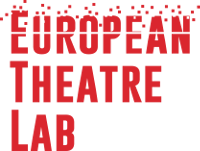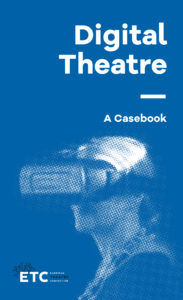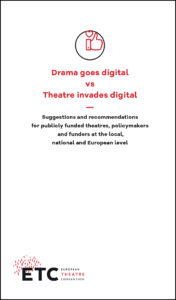The Field Survey, Part 1: Seeing
Summarizing the answers of the playful poll done at the conference “Digital Innovation in Theatre” in April in Karlsruhe, Germany, we find that there is a lot of best practice already out there. If you have other examples you would like to share, please let us know!
Talking about on stage production, most mentioned were Simon McBurney and his Theatre Complicité, especially the production The Encounter using binaurial 3D sound technology, Ex Machina with Robert Lepage’s 887 (Videomapping), the New Yorker Wooster Group, using video installations and sound technology connected to movement, and the theatre of Kris Verdonck. Nominated were also Myriam Gourfink (choreographer), Thierry de Mey’s Light Music, Jean Francois Peyret, Cie du Veilleur / Matthiew Roy, Alain Platel, Ivo van Hove’s Les Damnés, The Borderline Procession by Kay Voges, Der Jude von Malta by André Werner (Music Theatre), Corpus Pygmalion by Chris Ziegler, Bouncing in Bavaria by Auftrag : Lorey (Schauspiel Frankfurt), the video projection in the youth musical Kleider machen Leute (Theater an der Parkaue Berlin), and, last not least, Michael Jackson’s 3D hologram.
Various digital tools and projects used in theatres beyond the stage were mentioned in different contexts: InstaWalks at Theater Darmstadt, the Whatsapp service at Theater Würzburg and the National Theatre – live (in the UK). More generally, videos of productions on YouTube, livestreaming, marketing with trailers and on facebook, blogs giving background information, and the distribution and connections across borders were considered as good examples for digital innovation.
Video mapping was mentioned several times, also as an interactive technology, concretely a light installation on a building with a thermografic camera creating movements. Interaction is also appreciated in mobile phone voting, for example when the audience is asked to change the ending of a production (source of action), or the creation of an audience network via smartphone, live chats during the performance, on-screen projections of a whatsapp group or of tweets and the use of tablets (i.e. Rimini Protokoll).
In general, the combination of theatre and film on stage is valued, for example the use of cameras to focus on the actors on stage, and actors interacting with characters present only on video. Also, the augmentation of human bodies in dance performances on screen projections has been noted. In the audio sector, the combination of music and touch screens and 3D soundscapes were mentioned.
On the negative side, there were remarks on the complexity and intricacy of digital stage design and the high costs of digital technologies.
By Maren Dey, European Theatre Lab: Drama goes digital


